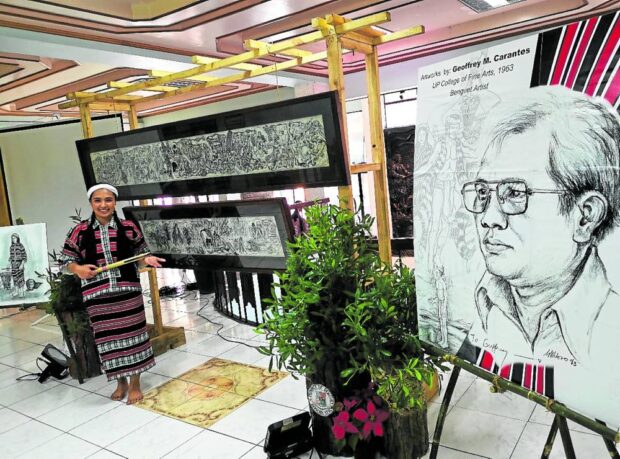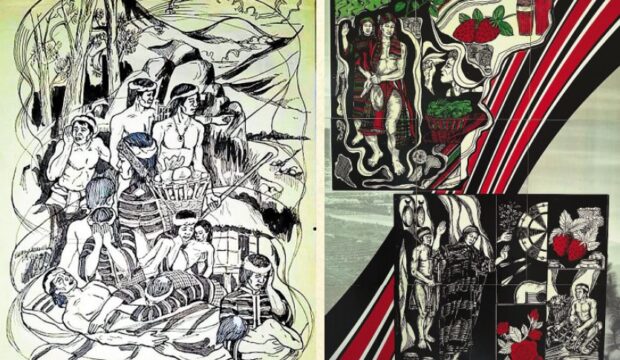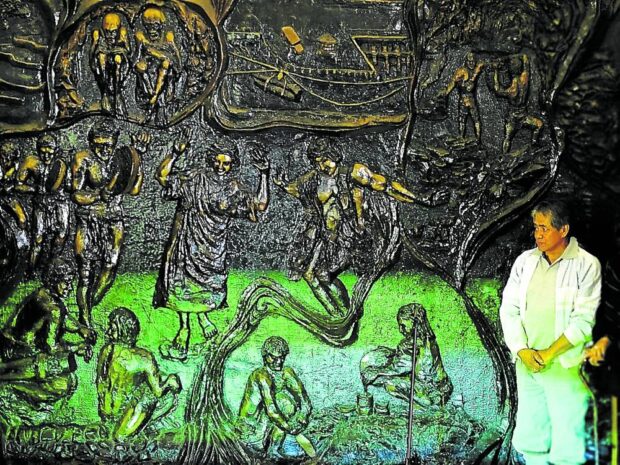A glimpse of Ibaloy history through art

ICON | The late Ibaloy illustrator and former University of the Philippines Baguio history instructor Geoffrey Carantes portrayed the precolonial and colonial lives of Ibaloys through pen-and-ink drawings that helped scholars visualize society during those periods. (Photo by EV ESPIRITU / Inquirer Northern Luzon)
BAGUIO CITY, Benguet, Philippines — An old sketch depicting an undated cholera outbreak that struck Ibaloy communities when the country was under the Spanish colonial government has officially become part of the Baguio Cultural Map, which records historic milestones, and indigenous Filipino traditions and knowledge that shaped the city, acknowledged as the Philippines’ summer capital.
This was rendered by the late Ibaloy illustrator Geoffrey Carantes and was kept by his daughter Lynette for decades since his death in February 1998.
Using years-worth of research materials, Carantes, a former history instructor at what was then the University of the Philippines (UP) College Baguio, portrayed the precolonial and midcolonial lives of Ibaloys through pen and ink drawings.
The drawings helped fellow scholars understand how society operated in those times, said Lynette, a former UP Baguio theater and communications instructor. The drawings have graced book covers, and were the inspiration for a carved mural displayed at the Benguet provincial capitol in La Trinidad town.
“[The cholera sketch] was his only drawing which I kept. [I was] scared to include [it] in many of [Carantes’ posthumous] exhibitions because it had images of death and sickness,” Lynette told the Inquirer in a recent interview.
Article continues after this advertisementLynette made the sketch public in 2020 when the COVID-19 pandemic struck.
Article continues after this advertisementCarantes’ drawings have been included alongside a Benguet cowboy hat, a “kayabang” (carrying basket for vegetables and root crops), and roughly 200 other “tangible” and “intangible” properties that make up Book 1 of the Baguio Cultural Mapping Project, according to the Baguio public information office.
Mapping details seen by the Inquirer indicated that the sketch was a reference to “a Spanish expedition” into Benguet that had been blamed for a “kulida” (cholera epidemic).

RELEVANT An old sketch (left) by Geoffrey Carantes depicts the time cholera struck the ibaloy
community during the Spanish colonial era, which his daughter, Lynette, separated from his
body of work (right) that was usually exhibited. Relevant today because of the COVID pandemic,
the sketch has been included in the Baguio Cultural Map. (Photo courtesy of the Carantes family)
READ: Baguio in the eyes of Ibaloys
READ: Ibaloys reconnect with past through photographs
READ: Ibaloy legacy, domain now part of Baguio cultural map
Virus fears
Former UP Baguio chancellor Raymundo Rovillos, a history professor, said paranoia over diseases was one of the reasons why Ibaloys and other Cordillera indigenous communities resisted and fended off all colonial attempts by Spain to subjugate them through “Christianization.”
“The silhouettes etched in the artwork are a representation of that historical era, [and] the resiliency of a people that continuously tried to cope with the disease that was [introduced by] Spanish attempts at colonization,” according to the mapping report.
It added: “The artwork defines a people’s response to the plague that has beset them. Key informants describe how diseases were managed in the early times and how the Benguet people had to sacrifice so much by giving away their children so as to prevent them from being infected.”
According to the mapping report, more than three decades ago, “Carantes had foreseen how art can be a necessary tool for education and as an effective channel to connect with one’s history.”
Baguio is often associated with the American colonial government which designed and built the city at the beginning of the 20th century. It hosts the century-old Teachers’ Camp which trains future educators in the country’s public school system.
The city is also where the country’s first land patent (Original Certificate Title No. 1) was recorded as the Americans imposed a public land mechanism for owning property.

MURAL | The distinct characters drawn by Geoffrey Carantes were used for book covers and inspired a mural at the Benguet provincial capitol. (Photo by EV ESPIRITU / Inquirer Northern Luzon)
Pushed aside
But Ibaloy legacy was a key feature of the Baguio Cultural Mapping Project, led by City Planning Officer Donna Tabangin, when it was first discussed by the city council in January last year.
The project officially recognized the city’s original inhabitants, some of whom were displaced when the city expanded or when their lands were expropriated for a military garrison that is now Camp John Hay.
Book 1 is the first of the three-volume Cultural Map that would be submitted to the Philippine Registry of Cultural Property, and includes a comprehensive oral and written account of old Ibaloy settlements, such as communities surrounding the Loakan Airport and the only recognized Ibaloy ancestral domain in Barangay Happy Hollow inside the Camp John Hay reservation.
Ibaloys are among the cultural mapping volunteers who helped gather oral and documented information about their Baguio ancestors, and some details go as far back as the 17th century, said author and retired UP Baguio professor Linda Grace Cariño.
Rosella Camte Bahni, for example, collected narratives from Ibaloy elders about small rice terraces in Loakan before their lands were taken in 1931 to build the airport.
She said many scholars believe Loakan was one of the oldest Ibaloy settlements of Mateo Carantes, Pingkisan, Apung Carantes, Aguyuspus, Gumdad, Komising Tugley, and Agonas Salome who grew rice to feed generations of Ibaloy residents there.
Bahni traces her roots to Batil and Dengay, her great-great-grandparents, who settled in what was then the Loakan Valley (Duakan) in the early 1800s.
Most of the narratives emphasize the spiritual and cultural connections Ibaloys have to their ancestral lands.